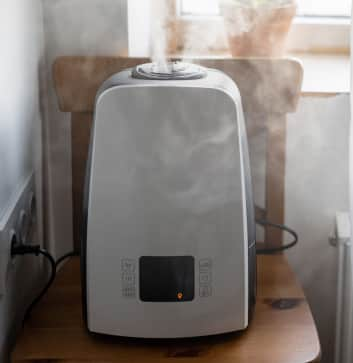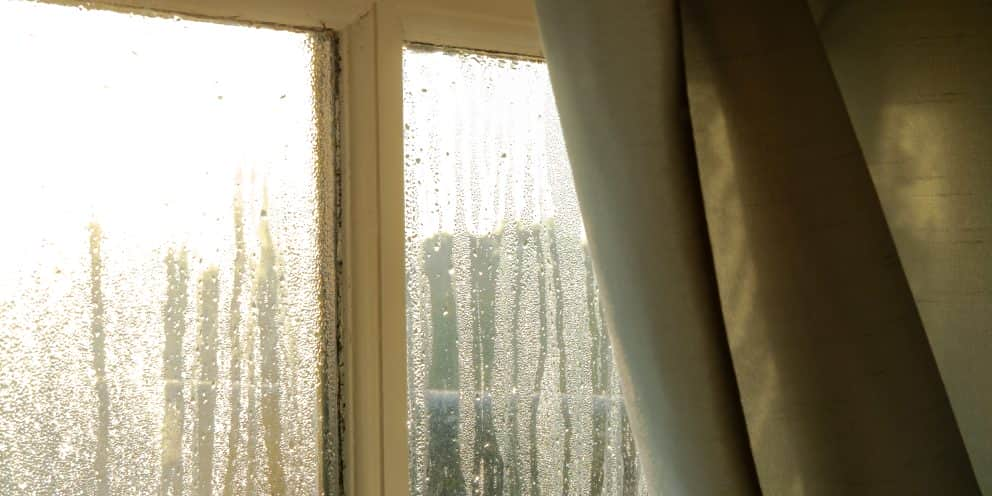Condensation on bedroom windows is often a result of temperature differences between the inside and outside of the room. When warm, moist air inside the bedroom meets a cold surface like a window, the air cools down, and its ability to hold moisture decreases. As a result, the excess moisture condenses on the cooler surface, forming water droplets.
On top of temperature variations between the inside and outside of the room, you will also be emitting water vapour during sleep. Whilst the amount will vary based on factors such as age, health, and environmental conditions, on average, an adult can release - 5 to 1 litres of water vapour per night through breathing and perspiration during sleep. If you have two people sleeping in a bedroom, you can easily double this average.
How much condensation
is normal?
Before we discuss how to stop condensation on bedroom windows, its important to clarify what is normal when it comes to condensation.
In a nutshell:
- If you have double or triple glazed windows, you should never experience in between the panes. If this does happen, the seals on the sealed unit have begun to fail and moisture is being drawn into the unit. You may have a ventilation issue that needs to be dealt with.
- Condensation on the outside of your bedroom windows means the air outside is warmer than the temperature of your double glazing. Outside condensation is a sign that your windows are doing a fantastic job of insulating your home - your windows are not allowing any heat transfer. Condensation on the outside of the window is common during early mornings in summertime when the air temperature outside is humid and warming fast, but the glass is still cool. This is normal and will clear as soon as the sun starts to warm the glass.
- Condensation forming on the inside of your bedroom windows, is typically the result of steam that may have formed from an en-suite shower or bath (where the door has been left open and the steam escapes into the bedroom), or high humidity/water vapour build up over night as we breathe and perspire during our sleep. Water vapour will always turn back into liquid form when it encounters a cooler surface, like a bedroom window.
Condensation on the inside of
double-glazed windows
If your home is adequately ventilated with some basic humidity busting measures in place, condensation should not be a problem, unless the condensation is on the inside of your double glazing.
Condensation on the inside of your double glazing can sometimes indicate high humidity levels in your home and you may have a ventilation problem. If water vapour has nowhere to go, it will condense your windows, as well as your furniture, in carpets, and on walls. It may be that the seals on the window unit have failed, and water is being drawn in.
The presence of excessive moisture in your home can cause considerable damage to both your residence and your family's well-being. Promoting air circulation and allowing fresh air to enter will enhance natural ventilation, reducing the likelihood of condensation forming on the interior of your windows.
Easy ways to prevent condensation building up on bedroom windows and the rest of your home
The most effective way to control condensation levels if to have the window or vent or bedroom door open with another window slightly open for ventilation.
Ventilating your bedroom and the rest of your home is crucial for maintaining good air quality and preventing issues like condensation. Here are some quick and effortless ways to improve ventilation:
Open windows and doors
The simplest way to ventilate a room is to open windows and doors. This allows fresh air to enter and stale air to exit. Do this regularly, especially during pleasant weather, open periodically during winter (when the central heating is turned off).
Open your bedroom window trickle vents if you have them and make sure they are clean and unobstructed.
Cross-ventilation
Open windows on opposite sides of your home to create cross-ventilation. This allows air to flow through the space, refreshing the indoor environment.
Keep internal doors open except when showering or cooking.

Dry laundry outside
Drying laundry outdoors reduces condensation in the home by allowing moisture to evaporate outside and promoting better air circulation. This natural method lowers indoor humidity levels, minimising the risk of condensation on surfaces like windows and walls. Outdoor drying is both energy-efficient and contributes to a healthier indoor environment by preventing mould growth associated with excess moisture.
Avoid putting very wet/damp clothes and towels over radiators.
Air circulation
Arrange furniture to allow for proper air circulation, preventing stagnant air pockets where moisture can accumulate. Avoid placing large pieces of furniture against walls or in front of vents.
Ceiling fans can help improve air circulation. In warm weather, set the fan to rotate counterclockwise to create a cooling breeze, and in colder months, set it to rotate clockwise to circulate warm air.
Seal gaps
Inspect windows and doors for gaps and seal them to prevent warm, moist air from entering the living space.
Proper insulation
Ensure proper insulation to minimise temperature differentials between indoor and outdoor surfaces, reducing the likelihood of condensation.
Use dehumidifiers
Use dehumidifiers to reduce excess humidity in the air. These devices remove moisture and help maintain an optimal indoor humidity level (usually between 30% and 50%).

The power of plants
Indoor plants can contribute to better air quality. They absorb carbon dioxide and release oxygen, promoting a healthier atmosphere.
Close windows during high humidity
In humid conditions, close windows, and doors when the outdoor air is more humid than the indoor air. Open them again when the humidity levels drop.
Regularly incorporating these practices into your routine can help create a well-ventilated and comfortable living environment. Adjust your ventilation strategies based on the season and specific needs of your home.
If you think your boiler or heating system is not operating as efficiently as it could, maybe it’s time for a boiler service. The team at Maintracts will have your system operating at optimum capacity in no time at all. Contact us for more information.

